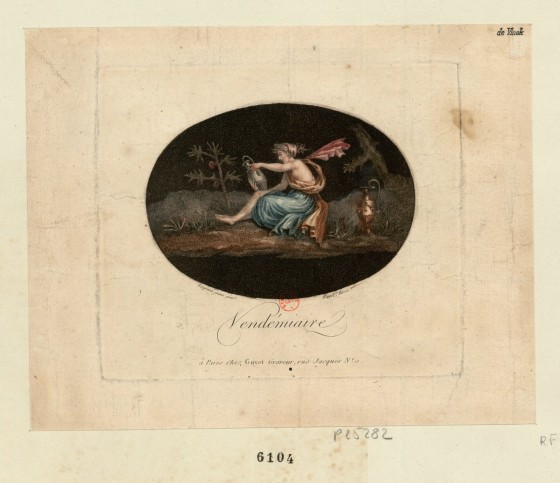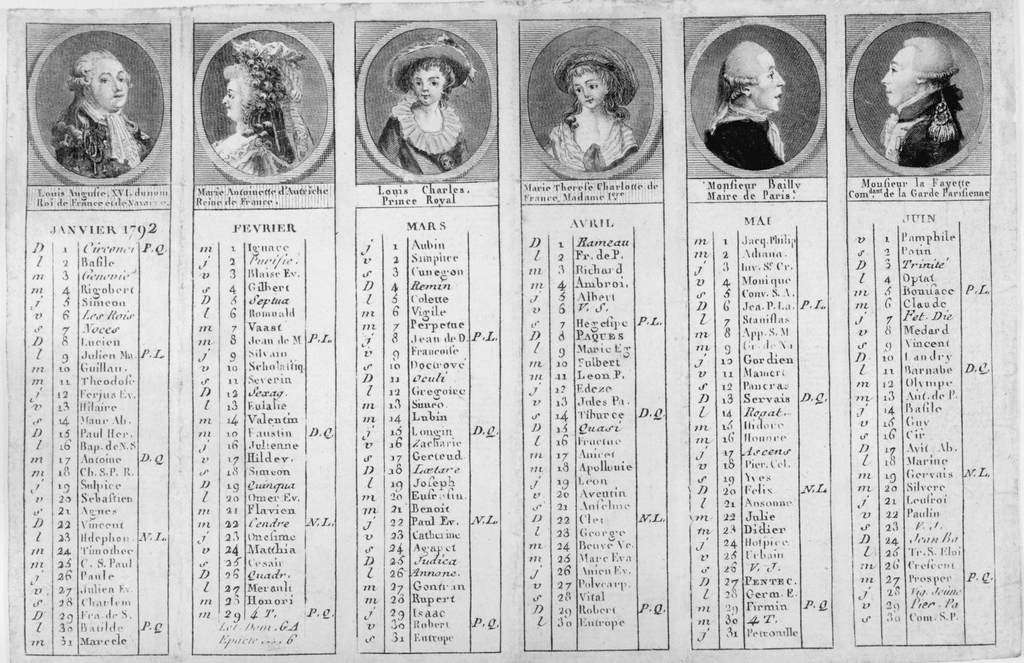This print is a French calendar for the first six months of the year 1792. The days of each month are lined up in a column, with the top of the column featuring a roundel with a portrait. To the right of the numerical dates are respective saints as per the Catholic calendar. The six portraits featured on the top row are as follows: Louis XVI, Marie Antoinette, Louis Charles, Marie Thérèse Charlotte de France, Jean Sylvain de Bailly and Gilbert du Motier, Marquis de Lafayette, respectively. Some of the historical highlights in 1792 includes the declaration of war on Austria on April 20th, the first use of the guillotine on April 25th, the storming of the Tuileries and imprisonment of the king on August 10th, the abolishing of the French monarchy on September 21th, and the beginning of Louis XVI’s trial on December 3rd.
For the majority of these six historical figures featured in the vignettes, the period from 1792 and 1793 would prove to be fatal. Following his trial, Louis XVI was guillotined on January 1793, and Marie Antoinette on October 1793. Sylvian de Bailly, the first mayor of Paris, was also executed in 1793 and Prince Louis Charles died in imprisonment at the Temple Prison in 1795. Of the survivors, Marie Thérèse, the eldest of Louis XVI and Marie Antoinette, was exiled to Vienna in 1796. Finally, General La Fayette is best known in the States for his role in the American Revolutionary Wars. Upon his return to France, La Fayette became the commander-in-chief of the National Guard of France in July 1789 and held the position until October 1791. Together with Bailly, he established a society in 1789 that attempted to neutralize the influence of radical Jacobins (they would later spearhead the Terror). Still, by August 1792, the General was declared as a traitor to the French nation and lived in captivity in Austria and Prussia throughout the reign of Terror. La Fayette eventually survived the French Revolution and retired from politics during the Napoleonic Empire.
This print can be read as more than a reminder of the last days of the French monarchy. In addition to dramatic political upheavals, the French Revolution overhauled the very system of measuring time. On September 21st, 1792, the new Republican Calendar was instituted, although this system would not be fully adopted until late 1793. This reformed calendar promoted a ten day week (décade), a change that parallels the establishment of the then brand new metric system.[1]
In addition to the ten-day week, the twelve months (with thirty days each!) were completely renamed. The first month of this new year became the day of the autumnal equinox in Paris and was called Vendémiaire, a word that derives from the Latin word, Vindemia, meaning grape harvest. Below is an etching depicting the personification of Vendémiaire.

Print, Vendémiaire, ca. 1794; Designed by Jean-Jacques Lagrenée, printed by Laurent Guyot, etching with engraving, 13.0 x 13.0 cm, Bibliothèque nationale de France, Paris, Inv. no. FRBNF40255977
In this republican calendar, all of the twelve months were given Latinate names inspired by the weather, and the seasons and the days lost their holy Catholic associations and were secularized. The names of days were instead inspired by animals, agricultural tools, grains, flowers, minerals and plants. The actor, writer, and politician Fabre d’Églantine was one of the masterminds behind this overhaul. Below is an excerpt from the national decree explaining the new calendar.
The French republican calendar was short lived and France converted back to the Gregorian calendar in 1805. Still, we should remember that there were large reforms to the system of time keeping, well before the French Revolution. The most well-known example is the conversion from the Julian to the Gregorian calendar, and in fact, Turkey did not fully convert to the Gregorian system until the twentieth century! Returning to the featured object, this partial calendar suggests that even in 1792, the French citizen would have organized their social and temporal surroundings under the aegis of the monarchy. Knowing what we know now, it is also a chilling yet nostalgic artifact: it would only be a matter of time before the guillotine would rupture time itself.
[1] See my earlier Object of the Day on the reforms on weights and measures during the French Revolution: Link Here
Cabelle Ahn was formerly an MA fellow in the Department of Drawings, Prints and Graphic Design at the Cooper Hewitt, Smithsonian Design Museum. She is currently a Ph.D candidate at Harvard University, focusing on eighteenth-century French drawings.

